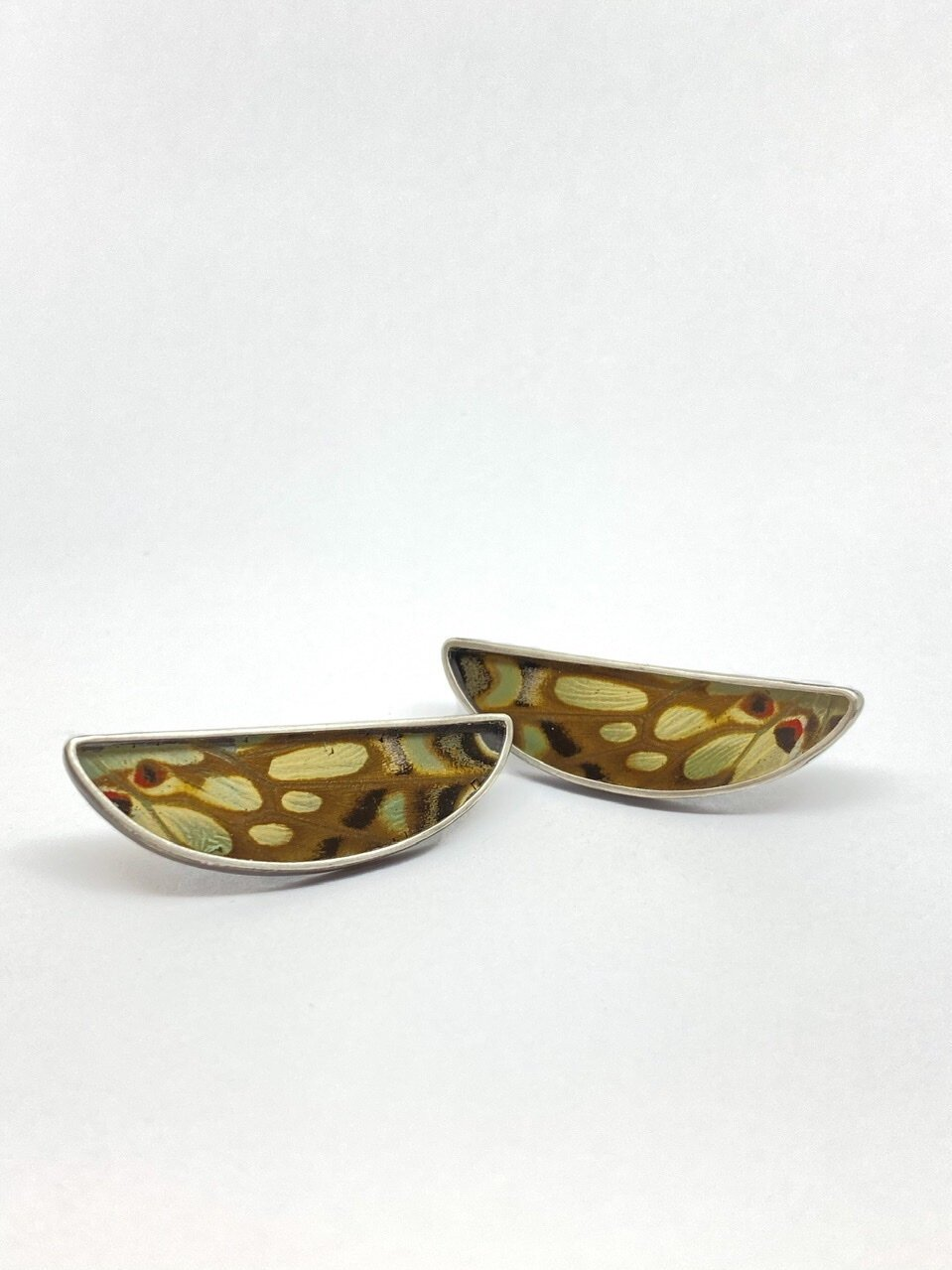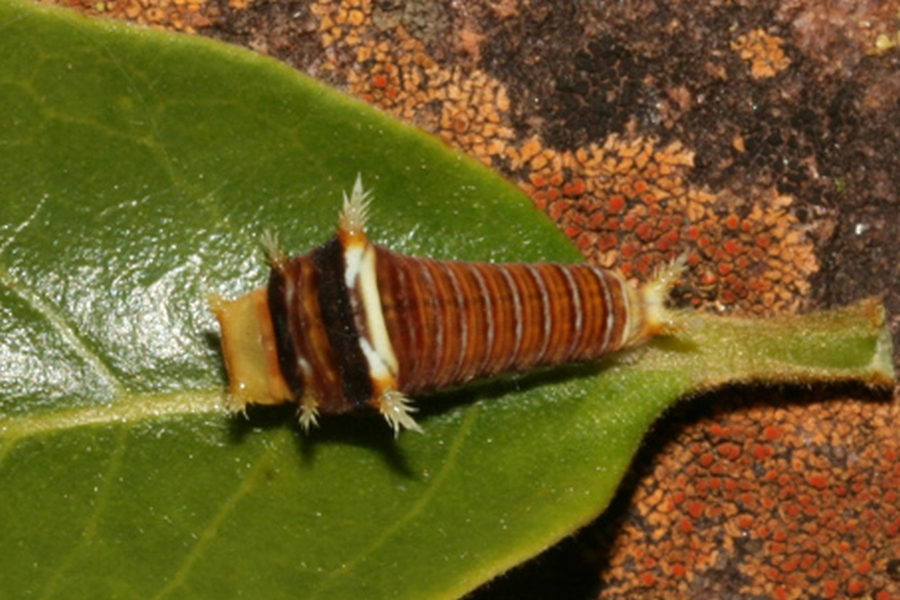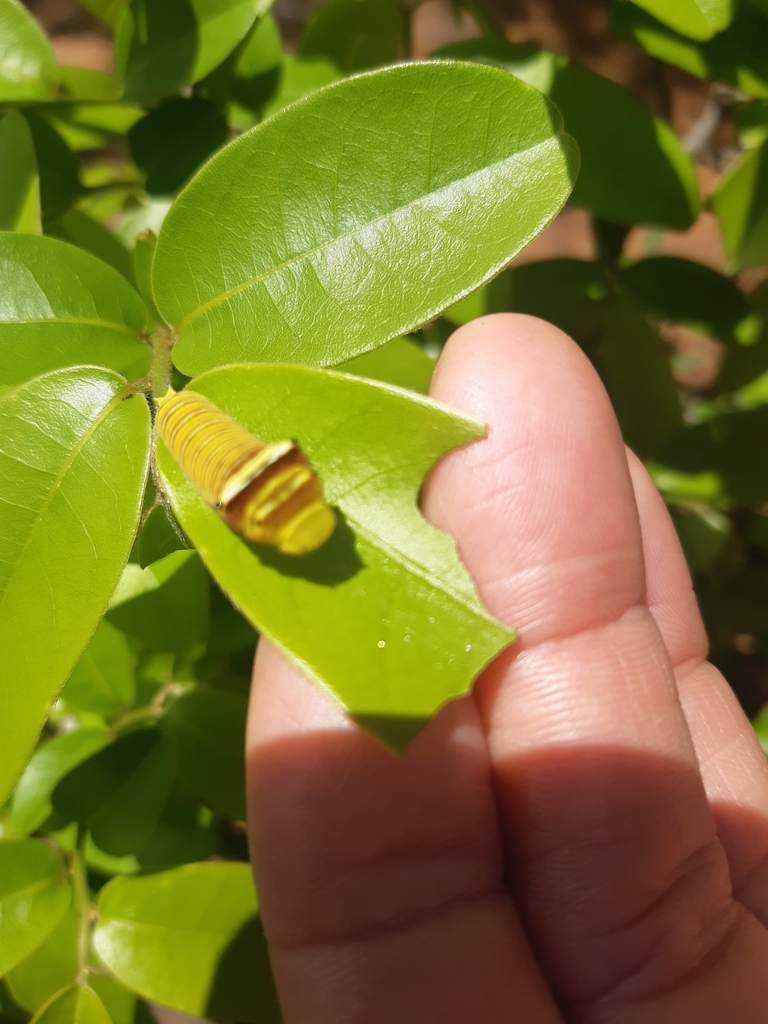Graphium antheus, the Large Striped Swordtail, is a very showy, popular African butterfly that has been displayed in several American gardens, zoos, and museums recently. It's not all that large--with a wingspan of about three inches, it might average a little bigger than our Tiger Swallowtails, but not much--and its stripes break up and look more like spots, but it is pretty.
Photo by Gcochrane13. The body can mimic a wasp's body, with stripes and a few stiff hairs at the tail end suggesting a sting/ The butterfly is harmless unless swallowed.
"Ryan" from the Florida Museum displays a freshly emerged adult antheus in the Butterfly House. At this stage of eclosion the butterfly is stretching its legs and wings while its wings develop, so it doesn't mind crawling over the young man's hands, and at this stage he doesn't need to worry about where those little feet have been. (That is a concern in the wild; if you're on safari you are likely to sweat, and composter species sometimes like to lick human sweat. They're friendly, they're pretty...they are still flies.)
They look similar to some otherAfrican butterflies. Clck here to see wings of an Antheus compared with wings of Graphium policenes. However, despite their resemblance, antheus and policenes are thought to be very different species. One source claims that antheus is more closely related to some Asian species than it is to policenes .Only one of the similar-looking species, G. evombar, is believed to be closely related to antheus.
You can tell antheus from policenes in the wild, if they hold still long enough, because the short stripes along the leading edge of each forewing are crooked ("S-shaped") in antheus and straight in policenes. In the wild they probably won't hold still long enough.
Here's another photo essay about East African butterflies, including antheus:
Antheus has been through a few name changes, or proposed names: antharis, hollandi, lurlinus, mercutius, nyassae, and utuba were proposed as names for this species while it was still classified in the genus Papilio, before Graphium was split off as a separate genus name. Antheus is now the standard name because it seems to have been recorded first, by Cramer and Stoll in 1780.
Map from GBIF. It has been found in many parts of sub-Saharan Africa, as far north as Libya and as far east as Indonesia, but may not be a regular resident of all the countries into which it has strayed..
Sometimes used as subspecies names are the old species names antharis, hollandi, lurlinus, mercutius, nyassae, utuba, and also atrantheus, combinata, comma, evombaroides, hoesemanni, latepictulus, mathieui, micrevombaroides, misanus, paradoxa, rubrimacula, scheffleri. In discussions of subspecies the nominate subspecies is referred to by the primary species name, repeated, but since antheus can be written with a ligature in Latin the nominate subspecies is sometimes listed as Graphium antheus anthaeus.
The Wikipedia page for this species does discuss the currently recognized subspecies (the author thinks they are mere "aberrations"). In case Kamala Harris is reading this...in the nineteenth century it was common and not considered plagiarism to insert a long quote into an article or book without attribution, but this is how we do it now.
"
Sierra Leone to Angola. — In ab.evombaroides Eim. the apical spot of the cell of the hindwing above is more or less united with the median band; otherwise not different from antheus.
West Africa. — In ab. utuba Hamps. the fourth and fifth transverse bands in the cell of the forewing are united posteriorly, forming a U-shaped spot; otherwise agreeing with nyassae.
Delagoa and British East Africa. — nyassae Btlr. has the middle cell of the hindwing beneath without the black and red spot; the transverse bars in the coll of the fore wing separated.
Natal to British East Africa. — ab. (var. ?) lurlinus Btlr. is somewhat larger than antheus and has the green markings of the upperside more extended, especially the transverse bars in the cell of the fore wing and the submarginal spots of both wings are nearly twice as large as in the latter.
Nyassaland and in the neighbourhood of Victoria Nyanza. mercutius Sm. & Kirby. Markings of the upper surface yellowish white; second and third transverse bands and again fourth and fifth transverse bands united to form a large, almost quadrate spot; the hindwing on both surfaces with a red spot in 1 c and 2 and beneath also with a red dot in cellule 7; the cell of the hinclwing on the other hand without red or black spot. Only one specimen known. Is perhaps only an aberration of the female of nyassae. Delagoa Bay. [4]
"
--Quote from Wikipedia, https://en.wikipedia.org/wiki/Graphium_antheus
Yes, Dowdypants, we do this even when quoting Wikipedia, and even if we wrote the article cited ourselves. (I didn't.) We do it this way in a blog post or an "informal" article or book. Wikipedia itself uses a more formal style for quotes, with footnotes, but does not edit for a consistent style (there are a few alternative styles). Professional journals and "serious" nonfiction books usually are edited for specific, consistent styles of footnoting or endnoting.
This popular species has appeared on postage stamps from Sierra Leone.
Collectors can buy the stamps at https://touchstamps.com/Stamp/Details/1462774/papu-tower-graphium-antheus .
They appear in pop art. You can buy photos and paintings as "wall art"...
...or greeting cards for all occasions...or iron-on patches:
...or wackier items like these earrings made from actual butterflies' hind wings, slowly fading between layers of plexiglass.
As regular readers know, there's concern that irresponsible "collecting" may wipe out local butterfly populations and the plants with which they live in symbiosis. There's also concern that a complete end to "collecting" may devalue butterflies whose value as pollinators not always appreciated. Picking up and using the wings of a butterfly who has died of old age, after flying for a month, is no worse than picking up and using the feathers an egret may drop right on an admiring birdwatcher. Probably it should be illegal only if the species is endangered, which Graphium antheus doesn't seem to be; it's not cruel to living birds or butterflies. But it could potentially encourage cruelty. So, considering the ethical implications, if you want to stick the wings of a deceased butterfly on your ears or know someone who does, here's the link.
Though pretty, these butterflies share some of the Kite Swallowtails' least appealing habits. They are pollinators and also composters.
At the GBIF site Ekioko, also in Kenya, posted a photo essay: Two caterpillars of this species side by side on one leaf. One caterpillar apparently climbing onto the back of the other's neck probably with evil intentions. Separated caterpillars. These caterpillars are not furry enough that they'd be likely to enjoy grooming each other, though it's noteworthy that the caterpillar apparently being attacked did not extrude its oxmeterium.
Monophagous caterpillars often are cannibalistic. They have an instinct to eat their own discarded skin, which is normally all they see of smell of other caterpillars' bodies. Their mothers are usually careful to lay each egg on a separate tree or at least a separate limb. If something goes wrong and they do meet other caterpillars, that instinct to eat their own shed skins kicks in and they seem not to care that this skin belongs to another caterpillar who is still using it. Some Swallowtail caterpillars do recognize that another skin of their own kind may belong to a relative, and that there can be survival benefits in staying close to their relatives. If this is counted as the test of caterpillars' intelligence, more Swallowtail species might fail than might pass. But monophagous species are designed to be unable to overpopulate and destroy their food plants. Nature only allows as many caterpillars to survive as the host plants can afford to support. Graphium antheus is not a truly monophagous species; it can live on several plants, but is likely to be limited to one or two plant
Antheus are found in "frost-free" areas at altitudes up to 1900 metres above sea level. They sometimes fly deep into forests. They fly fast and seldom let humans see them at rest. Their flight season is between September and April, but a few individuals fly in what sub-Saharan Africa call the winter months, too.. They are sometimes said to prefer red and yellow flowers, but are photographed visiting pink and white ones, too.
They pollinate many plants, including garden vegetables. I laughed out loud at the way Google abridged the caption of this Flickr photo, thinking it was a joke. Actually, the complete caption is informative, both about the butterfly and about the tropical vegetable North Americans might not recognize.
The butterflies' life cycle begins with mating, often acrobatically with the smaller butterfly (normally the male) hanging on to the female with some of those mysterious little parts of his tail end alone, legs waving in the air, no visible means of support. Should we even mention this? It might give some people's husbands or boyfriends ideas. Antheus is one of a minority of butterfly species where parents' lifespans normally overlap with their offspring's (by less than a week), so it's possible that the dangling butterfly in this photo might live to see his sons alive. It would make no difference to him. Butterflies seem to take no notice of caterpillars.
Etienne Terblanche's video begins with a long study of a waterfall, then spots a butterfly attracted to the water, follows him into the forest where he finds a mate, and documents that if a pair are startled and fly off together the dangling male can do some of the flying while upside down. So he's not completely useless during the short time he spends with the mother of his young.
Eggs are placed on separate plants and look like little pale green beads, about 1 mm in diameter, similar to G. policenes. They hatch in about four days.
Caterpillars look like those of G. policenes, too.
Photo by Wolf-Achim Roland, South Africa, December. Some older caterpillars remain brown while the bristly tufts of hair subside as the caterpillar matures, and some molt into green skins..
Photo by Marilizegreyling. He ate half of that leaf and he's not sticking around to be punished for it. At INaturalist you can see the photo sequence where he curls up and drops to the ground. He has an osmeterium but he knows it's not going to scare off Marilizegreyling.
Photo by Wolf-Achim Roland, South Africa; he notes that it was taken 16 days later, but it's a different caterpillar in a different area. The final caterpillar skin may be brown with bright orange and yellow stripes, or green with pale yellow and white stripes.
Caterpillars eat their way through five skins in about two weeks. When young they usually try to look like a shadow along the midline of a leaf, and nibble little holes along the middle. When older they eat from the edge inward and devour whole leaves. They strip branches, but plants survive.
Pupae are described as drab, more cylindrical and less distinctively contoured than policenes. Individuals may eclose in one week or pupate through several months. Emerging from pupation at different times allows more butterflies to live in a frost-free climate, where food plants grow continuously all year, without damaging food plant populations. As the museum guide known as Ryan explains, when siblings who pupated at the same time arrive at the museum, there's no way to predict when which of them will eclose and fly, no way for the museum to promise people a chance to see them flying until one actually is.
As in many Swallowtail species, females are usually ready to mate when their wings harden. Males usually have to spend a few days ingesting extra minerals to achieve sexual maturity. They get these minerals from brackish water and, for some species, polluted water, fresh dung, and fresh carrion. In the mating process, males transfer these minerals to females, who can thus afford to slurp up only fresh water and sweet nectar. Meanwhile, here is a video of male butterflies "puddling" or "lekking." (Puddling is a variety of lekking; some animals lek at places other than puddles.)
Lekking males may compete for status and try to attract females, who often approach the lek to check out their prospective mates, but they also cooperate to some extent in dodging predators. When a group of butterflies fly up all at once, a hungry bird may be more confused and less likely to catch any individual butterfly.
While many butterflies fly for a month or two, antheus live faster than most. Their adult lifespan is, on average, nine days.













No comments:
Post a Comment